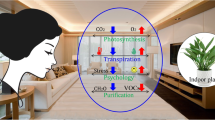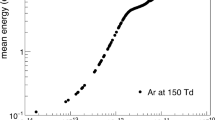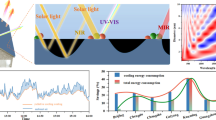Abstract
Bodies located in outdoor environments are radiatively heated in the daytime and cooled at night. Convective heat transfer is subsequently activated between the body surface and the surrounding air. To investigate these heat-exchange processes, we developed a new apparatus, referred to as a “polyethylene chamber”, for use in physical model experiments. The chamber is a 1.51-m-long tube with the ends serving as the air inlet and outlet, and is ventilated in the longitudinal direction by using an exhaust fan. The measurement section of the chamber is open but otherwise the device is covered with 0.02-mm-thick polyethylene film. Because such thin polyethylene film transmits approximately 85 % of both shortwave and longwave radiation, the model surface in the chamber is exposed to a radiation level almost equivalent to the outdoor radiation level. For example, at night the surface of the model is cooled by radiation, and subsequently, the air inside the chamber is cooled by the surface. Consequently, the outlet air temperature becomes lower than the inlet air temperature. The use of this temperature difference between the air inlet and outlet, together with other heat balance components, is a unique approach to the chamber technique for evaluating the heat exchange rate at a model’s surface. This report describes the design and heat balance of the chamber, and compares the heat-balance-based approach with another approach based on the radiation–convection balance on the model surface. To demonstrate the performance of the polyethylene chamber, two chambers were exposed to outdoor radiation on a clear night; one contained a leaf model. Air and surface temperatures were measured and the convective heat flux at the surfaces of the model and floor surface were calculated from the heat balance components of the chambers by assuming steady-state heat transfer. The fluxes agreed closely with those obtained from the radiation–convection balance at the model or floor surface. The results also clearly showed that the air flowing in the polyethylene chamber was cooled more efficiently when the model surface was installed in the chamber, even though the model surface temperature was high.









Similar content being viewed by others
Abbreviations
- \(a_\mathrm{f }\) :
-
Absorptivity of the floor for longwave radiation
- \(a_\mathrm{p }\) :
-
Absorptivity of the polyethylene film for longwave radiation
- \(a_{\mathrm{s{\text{- }}down}}\) :
-
Absorptivity of the polyethylene film for downward solar radiation
- \(a_{\mathrm{s{\text{- }}up }}\) :
-
Absorptivity of the polyethylene film for upward solar radiation
- \(A_\mathrm{f }\) :
-
Area of the floor surface (m\(^{2})\)
- \(A_\mathrm{p }\) :
-
Area of the polyethylene film surface (m\(^{2})\)
- \(A_\mathrm{w }\) :
-
Surface area of the sidewalls (m\(^{2})\)
- \(c_\mathrm{p }\) :
-
Specific heat of air at constant pressure (J K\(^{-1}\) kg\(^{-1})\)
- \(d \) :
-
Thickness of extruded polystyrene foam panel (= 0.03 m)
- \(h_{\mathrm{c{\text{- }}in }}\) :
-
Convective heat transfer coefficient at the inside polyethylene film surface (W m\(^{-2}\) K\(^{-1})\)
- \(h_{\mathrm{c{\text{- }}f }}\) :
-
Convective heat transfer coefficient at the floor surface (W m\(^{-2}\) K\(^{-1})\)
- \(h_{\mathrm{c{\text{- }}m }}\) :
-
Convective heat transfer coefficient at the leaf model surface (W m\(^{-2}\) K\(^{-1})\)
- \(h_{\mathrm{c{\text{- }}out }}\) :
-
Convective heat transfer coefficient at the outside polyethylene film surface (W m\(^{-2}\) K\(^{-1})\)
- \(h_\mathrm{t }\) :
-
Heat transmission coefficient (W m\(^{-2}\) K\(^{-1})\)
- \(L_{\mathrm{f{\text{- }}up }}\) :
-
Longwave radiation flux density directed upward at the floor surface (W m\(^{-2})\)
- \(L_{\mathrm{n{\text{- }}a }}\) :
-
Net longwave radiation flux density above the polyethylene film (W m\(^{-2})\)
- \(L_{\mathrm{n{\text{- }}b }}\) :
-
Net longwave radiation flux density below the polyethylene film (W m\(^{-2})\)
- \(L_{\mathrm{p{\text{- }}down }}\) :
-
Longwave radiation flux density directed downward at the inside film surface (W m\(^{-2})\)
- \(L_{\mathrm{p{\text{- }}up }}\) :
-
Longwave radiation flux density directed upward at the outside film surface (W m\(^{-2})\)
- \(L_{\mathrm{sky }}\) :
-
Longwave radiation flux density of the sky (W m\(^{-2})\)
- LAI :
-
Leaf area index
- \(Q_{\mathrm{c{\text{- }}f }}\) :
-
Convective heat flux at the floor surface (W)
- \(Q_{\mathrm{c{\text{- }}m }}\) :
-
Convective heat flux at the leaf model surface (W)
- \(Q_{\mathrm{g{\text{- }}f }}\) :
-
Conductive heat flux through the floor (W)
- \(Q_{\mathrm{g{\text{- }}w }}\) :
-
Conductive heat flux through the sidewall (W)
- \(Q_\mathrm{h }\) :
-
Heat supplied by the heating cable (W)
- \(Q_\mathrm{p }\) :
-
Heat transmission flux through the polyethylene film (W)
- \(Q_\mathrm{v }\) :
-
Heat flux due to ventilation (W)
- \(r_\mathrm{f }\) :
-
Reflectivity of the floor surface for longwave radiation
- \(r_\mathrm{p }\) :
-
Reflectivity of the polyethylene film for longwave radiation
- \(r_{\mathrm{s{\text{- }}down }}\) :
-
Reflectivity of the polyethylene film for downward shortwave radiation
- \(r_{\mathrm{s{\text{- }}f }}\) :
-
Reflectivity of the floor surface for shortwave radiation
- \(r_{\mathrm{s{\text{- }}up }}\) :
-
Reflectivity of the polyethylene film for upward shortwave radiation
- \(R_{\mathrm{n{\text{- }}a }}\) :
-
Net radiation flux above the polyethylene film (W)
- \(R_{\mathrm{n{\text{- }}b }}\) :
-
Net radiation flux below the polyethylene film (W)
- \(R_{\mathrm{n{\text{- }}f }}\) :
-
Net radiation flux at the floor surface (W)
- \(R_{\mathrm{n{\text{- }}m }}\) :
-
Net radiation flux at the upper surface of the leaf model (W)
- \(S \) :
-
Outdoor shortwave radiation flux density (W m\(^{-2})\)
- \(S_{\mathrm{f{\text{- }}up }}\) :
-
Shortwave radiation flux density directed upward at the floor surface (W m\(^{-2})\)
- \(S_{\mathrm{n{\text{- }}a }}\) :
-
Net shortwave radiation flux density above the polyethylene film (W m\(^{-2})\)
- \(S_{\mathrm{n{\text{- }}b }}\) :
-
Net shortwave radiation flux density below the polyethylene film (W m\(^{-2})\)
- \(S_{\mathrm{p{\text{- }}down }}\) :
-
Shortwave radiation flux density directed downward at the inside film surface (W m\(^{-2})\)
- \(S_{\mathrm{p{\text{- }}up }}\) :
-
Shortwave radiation flux density directed upward at the outside film surface (W m\(^{-2})\)
- \(t_\mathrm{p }\) :
-
Transmissivity of the polyethylene film for longwave radiation
- \(t_{\mathrm{s{\text{- }}down }}\) :
-
Transmissivity of the polyethylene film for downward solar radiation
- \(t_{\mathrm{s{\text{- }}up }}\) :
-
Transmissivity of the polyethylene film for upward solar radiation
- \(T_\mathrm{f }\) :
-
Floor surface temperature (\(^\circ \)C)
- \(T_{\mathrm{in }}\) :
-
Air temperature inside the polyethylene chamber (\(^\circ \)C)
- \(T_{\mathrm{inlet }}\) :
-
Air temperature at the air inlet of the polyethylene chamber (\(^\circ \)C)
- \(T_\mathrm{m }\) :
-
Leaf model surface temperature (\(^\circ \)C)
- \(T_{\mathrm{out }}\) :
-
Outdoor air temperature (\(^\circ \)C)
- \(T_{\mathrm{outlet }}\) :
-
Air temperature at the air outlet of the polyethylene chamber (\(^\circ \)C)
- \(T_\mathrm{p }\) :
-
Polyethylene film temperature (\(^\circ \)C)
- \(V \) :
-
Ventilation rate of the exhaust fan (m\(^{3}\) s\(^{-1})\)
- \(\varepsilon _\mathrm{f }\) :
-
Emissivity of the floor surface
- \(\varepsilon _\mathrm{m }\) :
-
Emissivity of the leaf model surface
- \(\varepsilon _\mathrm{p }\) :
-
Emissivity of the polyethylene film
- \(\lambda \) :
-
Heat conductivity of extruded polystyrene foam (= 0.04 W m\(^{-1}\) K\(^{-1})\)
- \(\rho \) :
-
Air density (kg m\(^{-3})\)
- \(\sigma \) :
-
Stefan–Boltzmann constant (= 5.67\(\times \)10\(^{-8}\) W m\(^{-2}\) K\(^{-4})\)
- \(\Delta T_\mathrm{a }\) :
-
Air temperature difference between the inlet and the outlet of the polyethylene chamber (outlet–inlet) (\(^\circ \)C)
- \(\Delta T_\mathrm{f }\) :
-
Temperature difference between the inside and the outside surface of the floor (inside–outside) (\(^\circ \)C)
- \(\Delta T_\mathrm{w }\) :
-
Temperature difference between the inside and the outside surface of the sidewall (inside–outside) (\(^\circ \)C)
References
Chen JM, Ibbetson A, Milford JR (1988a) Boundary-layer resistances of artificial leaves in turbulent air: I. Leaves parallel to the mean flow. Boundary-Layer Meteorol 45(1–2):137–156
Chen JM, Ibbetson A, Milford JR (1988b) Boundary-layer resistances of artificial leaves in turbulent air II: leaves inclined to the mean flow. Boundary-Layer Meteorol 45(4):371–390
Daudet FA, Silvestre J, Ferreira MI, Valancogne C, Pradelle F (1998) Leaf boundary layer conductance in a vineyard in Portugal. Agr For Meteorol 89(3):255–267
Funk JP (1959) Improved polythene-shielded net radiometer. J Sci Instrum 36:268–270
Hino M, Kanda M (1989) Study on the climate moderation effect of plant by lysimeter with wind-tunnel. J Jpn Soc Hydrol Water Resour 2(1):61–69 (in Japanese with English abstract)
Kitano M, Tateishi J, Eguchi H (1995) Evaluation of leaf boundary layer conductance of a whole plant by application of abscisic acid inhibiting transpiration. Biotronics 24:51–58
Linacre ET (1967) Further studies of the heat transfer from a leaf. Plant physiol 42(5):651–658
McAdams WH (1954) Heat transmission, 3rd edn. McGraw Hill, New York 249 pp
Morrison JE Jr, Barfield BJ (1981) Transpiring artificial leaves. Agric Meteorol 24:227–236
Narita K, Mikami T, Sugawara H, Honjo T, Kimura K, Kuwata N (2004) Cool-island and cold air-seeping phenomena in an urban park, Shinjuku-Gyoen, Tokyo. Geogr Rev Jpn 77(6):403–420 (in Japanese with English summary)
Okada M (1983) The measurement of infrared properties of plastic films by means of a commercial emissivity measuring instrument. J Agric Meteorol 39(1):31–34 (in Japanese)
Okada M, Hayashi M (1983) Proposing an equation to evaluate greenhouse heat transmission. J Agric Meteorol 39(2):91–95 (in Japanese with English summary)
Okada M, Hamasaki T, Hayashi T (1995) Temperature gradient chambers for research on global environment change. 1. Thermal environment in a large chamber. Biotronics 24:85–97
Parkhurst DF, Duncan PR, Gates DM, Kreith F (1968) Wind-tunnel modelling of convection of heat between air and broad leaves of plants. Agr Meteorol 5(1):33–47
Parlange JY, Waggoner PE, Heichel GH (1971) Boundary layer resistance and temperature distribution on still and flapping leaves I. Theory and laboratory experiments. Plant Physiol 48(4):437–442
Thom AS (1968) The exchange of momentum, mass, and heat between an artificial leaf and the airflow in a wind-tunnel. Q J R Meteorol Soc 94(399):44–55
Acknowledgments
We thank Prof. Makio Hayashi at Tokai University for technical support in measurements of the radiative properties of the PE films used in the PE chamber. This research was supported by the Research Program on Climate Change Adaptation (RECCA) of the Ministry of Education, Culture, Sports, Science and Technology of Japan (MEXT).
Author information
Authors and Affiliations
Corresponding author
Appendix: Shortwave (Solar) Radiation Balance Inside and Outside the PE Chamber
Appendix: Shortwave (Solar) Radiation Balance Inside and Outside the PE Chamber
Net shortwave radiation above and below the PE film, \(S_{\mathrm{n{\text{- }}a}}\) and \(S_{\mathrm{n{\text{- }}b}}\), can be expressed by defining \(S_{\mathrm{p{\text{- }}up}}\) as the shortwave radiation at the outside film surface directed upward and \(S_{\mathrm{p{\text{- }}down}}\) as the shortwave radiation at the inside film surface directed downward, hence
Upward directed shortwave radiation at the floor surface, \(S_{\mathrm{f{\text{- }}up}}\), is equal to the radiation reflected by the floor surface, and is given by
The radiative characteristics of the PE film, in particular its reflectivity, largely depend on the incident angle of radiation. The downward radiation incident on the outside film surface from the sun and the sky consists of direct beams and scattered radiation, whereas the upward radiation incident on the inside film surface from the floor usually consists of scattered radiation, unless the floor surface is shiny. The characteristics are different for different directions of radiation; therefore, we define transmissivity, reflectivity, and absorptivity separately for downward and upward radiation. Two components, \(S_{\mathrm{p{\text{- }}up}}\) and \(S_{\mathrm{p{\text{- }}down}}\), are given by
Substituting Eqs. 32 and 33 into Eqs. 29 and 30, we obtain
The difference between net shortwave radiation values above and below the PE film is obtained by subtracting Eq. 35 from Eq. 34,
Outdoor global shortwave radiation, \(S\), is significantly larger than upward shortwave radiation at the floor surface, \(S_{\mathrm{f{\text{- }}up}} (S\,\gg \, S_{\mathrm{f{\text{- }}up}})\). Therefore, the net shortwave radiation below the PE film (inside the chamber) is reduced and the extent of the reduction depends on the outdoor shortwave radiation and the absorptivity of the PE film for incoming shortwave radiation. The absorptivity of a transparent PE film is 5 % or less when the film is as thin as 20 \(\upmu \)m.
Rights and permissions
About this article
Cite this article
Okada, M., Okada, M. & Kusaka, H. A Polyethylene Chamber for Use in Physical Modelling of the Heat Exchange on Surfaces Exposed to a Radiation Regime. Boundary-Layer Meteorol 153, 305–325 (2014). https://doi.org/10.1007/s10546-014-9946-y
Received:
Accepted:
Published:
Issue Date:
DOI: https://doi.org/10.1007/s10546-014-9946-y




